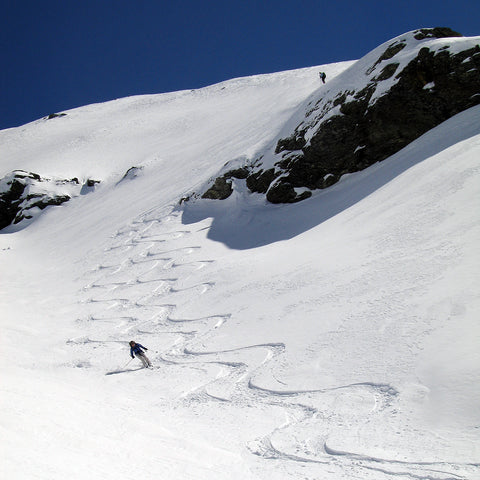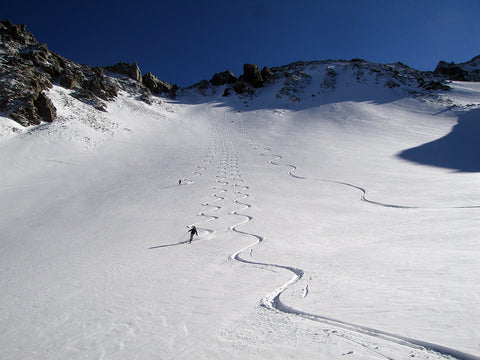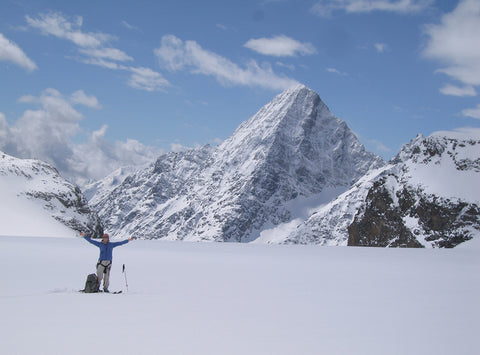Free shipping on US orders $120 and up (restrictions apply)
Free shipping on US orders $120 and up (restrictions apply)
Climbing Gym
Rentals
Gear Shop
Mountain Resources

How to Find the Good Snow in the Backcountry
December 04, 2019 5 min read

The first thing to realize: there is no bad snow, only bad skiers. Learning to ski is a lifelong process and none of us are as good as we can be. Backcountry snow is variable. To improve control and efficiency in the backcountry, which translates to increased safety and enjoyment, we should develop a wide range of ski techniques and tactics that allow for adjustments for changes. We need to consider how our lift-assisted skiing style might be adapted for skiing with a bigger pack, in a remote setting, on natural, untracked snow.
As we develop our ski technique to handle all backcountry conditions, we should also be developing an eye for terrain. Terrain assessment and terrain utilization skills are the most useful assets for any backcountry traveler who is making decisions about where to go to maximize safety and enjoyment. Unfortunately, they are also among the most time consuming skills to develop. There are no shortcuts and no substitutes for experience. Developing these skills involves getting out there and being observant. The more we do, the faster we learn. Observe patterns and trends regarding how the snow surface changes over space and time. Snow quality will vary somewhat predictably with a combination of slope angle (steepness), slope aspect (direction it faces), slope configuration (terrain shape, forest cover), elevation, and snowpack depth. All of these variables relate to the interaction between terrain and weather.

Weather is the driving force in the variability of snow quality in the mountains. Weather factors that directly affect snow quality in the upper snowpack are: wind, sun, precipitation, and temperature.
Wind has a profound affect on snow quality. Moderate winds can be enough to move snow from one place to another. This can create deeper powder skiing conditions in certain sheltered places. These places change depending on the speed and direction of the wind. Strong winds can lift the snow up into the air and cause it to be deposited in unusual places, or even sublimate back into the atmosphere. Strong winds can scour and harden the snow surface. This can leave an edgeable, smooth surface that is fun to ski, or it can be bumpy and sculpted with wind ridges called “sastrugi.” Often the wind forms a smooth, thin wind crust over the top of soft snow. If this crust is breakable under the weight of a skier, the conditions can be challenging at best.

Sun has a dramatic effect on snow quality. Solar radiation on a slope is affected by the cloud cover, the angle of the sun in the sky, the time of season, the angle – aspect – configuration of the terrain relative to the sun, the characteristics of the snow on and near the surface, and the amount of bare Earth able to re-radiate energy back to the snow surface. Slopes with aspects that get less sun have very different qualities from those that get more. Assessing the effects of sun on snow quality can be challenging, as little differences can change conditions dramatically. We are fortunate that in the Sierra in springtime, we generally enjoy a winning combo of deep, strong snowpack, strong sun, and below freezing nighttime snow temperatures that provide reliably good corn skiing in times of fair weather. In springtime, it still can be complex though because it is not just where you go that matters, but when you go there.
Precipitation here refers to the things that come out of the air and affect the snow conditions on the surface. Clearly, new snow changes the quality of the skiing. Alongside smooth corn snow, fresh powder is one of the great joys of skiing, and life. The type of snow that falls from the sky, and the conditions within a storm from which it falls affects the quality of the skiing during and immediately after a storm. One of the most unwelcome weather conditions we as backcountry recreationists face is the precipitation known as rain, specifically when it falls on snow. Sometimes rain on snow can be helpful for snow conditions, but generally not. Rime is another form of precipitation that can form on summits and ridges and create crusty, bumpy snow conditions.

Lastly, we have temperature. Temperature does its magic by helping to change the strength of the bonds between ice grains in the snow. In the daytime, temperature works in cooperation with the sun to have its effects. At night temperatures alone can help form or break bonds. Cold air and cold surface snow, well below freezing, generally result in weaker snow being created on the surface, and improved ski conditions often called “recycled powder.” Corn is created with warmer daytime temps followed by colder overnight temps. Temperature changes during storms have a significant effect on skiing quality. If a storm comes in cold and ends warmer, it can create challenging “upside down” conditions. Warmer air masses can hold more moisture than colder ones. This is why the biggest storms that produce the most precipitation in the mountains tend to originate in the warm tropics.
As you can see, finding the good snow in the backcountry is both science and art. Best thing to do to learn about it is to make predictions and then get out there and observe. The big obstacle to learning here that I haven’t mentioned is that the backcountry is exceptionally hazardous, with special concern for avalanches. If you haven't taken an avalanche awareness course to learn how to prepare for, plan, and execute a successful backcountry outing as a team, then you have no business finding the good snow yet. Avalanche risk is real and assessing it is even more complex than finding the good snow. This is because avalanches can release from any depth in the snowpack. We have to be able to anticipate relevant characteristics of snow surfaces from earlier in the season that we can no longer observe from the current surface. We have to understand about how avalanches form and release to comprehend the consequences they can have in the terrain we wish to enjoy. We have to learn to use terrain and our team to manage our risk. It is especially tricky because quite often it is the case that where we find the best snow conditions, we also find the greatest avalanche hazard.
The prescription here is:
• Take an AIARE 1 avalanche course. Continue and refresh your avalanche education regularly.
• Get the required equipment and teammates to go to the backcountry with.
• Go to your local avalanche information center, like the Eastern Sierra Avalanche Center, for a wealth of weather and snowpack resources, along with expert analysis of conditions and regional backcountry travel advice.
• Be observant in the backcountry. Write down what you expect to find, and what you actually find. Debrief every outing and extract lessons learned.
• Find mentors. Mountain guides are a great choice if you have the budget.
• Use your community. Sierra Mountain Guides posts useful conditions reports for the Eastern Sierra. Reputable local backcountry skiers and snowboarders can be a resource through conversations, social media, and trip reports. Always evaluate conditions for yourself though in the end. People make poor decisions and get away with it all the time, and things can change significantly overnight.
If you find yourself encountering bad snow often, and it’s not because your skiing skills are lacking, consider improving your terrain skills. It is rare that the goods don’t exist out there. More often, we just have to know where to find them. Happy hunting!

Leave a comment
Comments will be approved before showing up.
Subscribe
Sign up to get the latest on sales, new releases and more …





